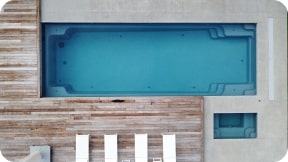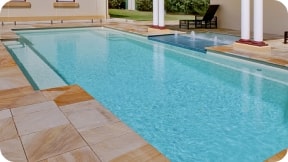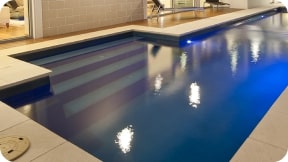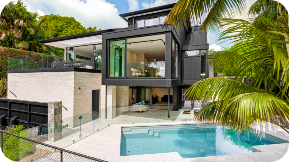Articles
Pool Fencing - what are the rules?
Pool fencing 101:
What are the rules when it comes to fencing swimming pools in New Zealand?
One major thing to consider when planning your new swimming pool area is pool fencing. Every swimming pool in New Zealand is required to have an adequate barrier in order to prevent unsupervised children from accidental drowning. As a pool owner it is your responsibility to ensure that your pool area is safe and secure.
Swimming Pool fencing is governed by the NZ building code and is described in clause F9.
F9 states that the functional requirement is that: “Residential pools with a maximum depth of water of 400 mm or more that are filled or partly filled with water must have means of restricting access that prevents unsupervised access by a child under 5 years of age”.
In short, the rules say that your immediate pool area must be fully enclosed.
One of the first things to get your head around is what constitutes and immediate pool area. To put it simply, the idea is that your pool area is strictly for the pool and activities associated with the pool (like sun-bathing, outdoor dining etc).
Here is how F9 defines an immediate pool area:
“Immediate pool area means the land in or on which the pool is situated and so much of the surrounding area as is used for activities carried out in relation to or involving the pool.”
Which means that you can’t plan to have things that aren’t related to the pool inside your pool area (like a clothesline or veggie garden). Likewise, your pool area cannot be used as a thoroughfare to other areas that aren’t related to the pool.
A quick guide on some of the key things you need to know when planning your pool area:
Note: the below is a simple summary of the rules but by no means is a comprehensive overview. For full details you can download a copy of the acceptable solutions here.
Pool fences/barriers within your property:
This means fences or barriers that prevent access from part of your property into the pool area. The main points to take into consideration when planning your pool are

This means fences or barriers that prevent access from part of your property into the pool area. The main points to take into consideration when planning your pool are
- The barrier must be at least 1200mm high from the ground level outside of the pool enclosure.
- If there is a gap from the ground level to the start of the fence/barrier face it must be less than 100mm
- There cannot be any climbable objects within 1200mm of the fence/barrier
- The barrier must be unclimbable (which means the face of the fence can’t have horizontal gaps of more than 10mm if using horizontal slats or any climbable protrusions).
- The barrier must have no openings that a 100mm diameter sphere could pass through.
Boundary fences:
If a boundary fence forms part of your pool area, then you need to take special precaution to ensure that the fence is designed to prevent access from the neighbour’s side. Because you can’t control what your neighbours do on their side of the fence, there are special requirements in addition to the standard fencing rules mentioned above.
If a boundary fence forms part of your pool area, then you need to take special precaution to ensure that the fence is designed to prevent access from the neighbour’s side. Because you can’t control what your neighbours do on their side of the fence, there are special requirements in addition to the standard fencing rules mentioned above.
- Boundary fences need to be 1800mm high on the pool side.
- They must have a 900 mm high non-climbable zone on the pool side of the barrier that begins not more than 150 mm from the top.
- They must be positioned at least 1000mm away from the water’s edge (so a child cannot fall off the boundary fence and into the pool).
Gates:
All gates that provide access to the pool area must:
All gates that provide access to the pool area must:
- Open outward (away from the pool)
- Be at least 1200mm high
- Be self-closing to the fully closed and latched position
- Must have a latch positioned in a way that prevents a child from reaching it. (in other words, an effective 1500mm reach).
What if my house or another building on my property forms part of the pool fence /barrier?
That’s okay too, but you’ll need to make sure access from those buildings into the pool enclosure is also restricted. Here’s a few things to think about:
That’s okay too, but you’ll need to make sure access from those buildings into the pool enclosure is also restricted. Here’s a few things to think about:
- Make sure all windows that open into the pool area are fitted with stays that prevent them from opening more than 100mm. this will stop children from being able to climb through them.
- Make sure any doors that open into the immediate pool area are:
- Single-leaf doors (not bifold or French doors)
- Are no more than 1000mm in width
- Are self-closing or fitted with an audible alarm which sounds while open
- Have a self-latching device, that must be released manually to re-open the door. The release for said latch must be positioned no less than 1500mm from the inside floor level.
- Have appropriate signage next to the door handle that says “swimming pool. Close the door”.
A quick pool safe checklist:
- Is the pool area limited to the pool and pool-related activity?
- Is the fence at least 1.2m high?
- Are boundary fences 1.8m high on the pool side?
- Are there no gaps greater than 100mm in the fencing?
- Is access restricted from buildings that form part of the barrier (windows latch, self-closing doors)
- Do gates open outwards?
- Do gates automatically shut?
- Are gate latches self-latching?
Need help getting your pool plan right?

For most people navigating the different rules around swimming pool fencing can feel like hard work – there is so much to think about and it can be a challenge to get everything right.
We’d love to help you! Our authorised Compass Pools dealers can help you navigate the finer details so that you achieve a pool area that you are truly happy with. We’ll help you figure out the best place to position your pool and we can discuss the different fencing options to ensure you comply with the rules.
You can also download a detailed copy of the acceptable solutions right here .
Read more articles























.png)




